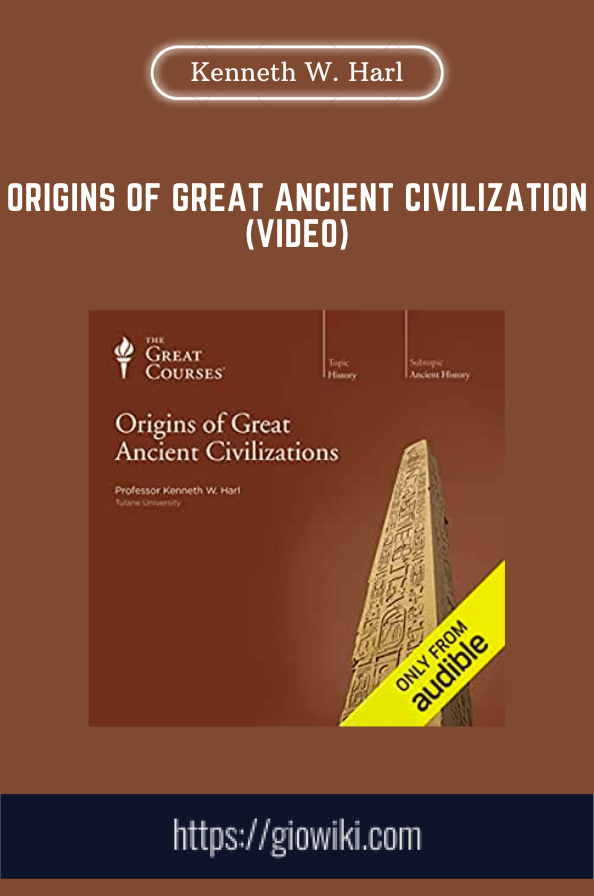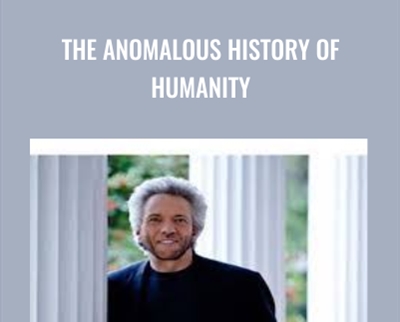Origins of Great Ancient Civilization (Video) – Kenneth W. Harl, Ph.D
$49.00
Origins of Great Ancient Civilizations offers these and other insights in a fast-paced introduction that will give you a new appreciation of our own roots and a rock-solid foundation for deeper exploration.
Salepage link: At HERE. Archive: https://archive.is/1vrfR
Course Overview
The ancient civilizations of the Near East can seem remote. For many of us, places such as Mesopotamia or the Indus valley … or the Hittite or Assyrian peoples … or rulers such as Sargon, Hammurabi, and Darius … are part of a long-dead antiquity, so shrouded with dust that we might be tempted to skip over them entirely, preferring to race forward along history’s timeline in search of the riches we know will be found in our studies of Greece and Rome.
That very remoteness, and our willingness to shunt aside these great civilizations, should be reason enough to study them, according to Professor Kenneth W. Harl. And remoteness, he emphasizes, is far from the only reason that demands our attention to the ancient cultures visited in Origins of Great Ancient Civilizations.
These civilizations “act as the cultural basis for many of the civilizations that will emerge on the Eurasian landmass and will dictate the destinies of many of the people living today on the globe.
“Mesopotamia,” he says, citing the ancient name for Iraq, the earliest civilization we know of, “perhaps more than any other civilization we shall look at, will really set the basis for what a civilization should be; that is, it should be urban-based; it should be literate; it should be based on intensive agriculture; and it also will depend very heavily on trade—not just local and regional markets, but long-distance trade.”
Another example of the contributions made by these civilizations, of course, is in the concept of a “transcendent, monotheistic God.
“How that notion comes about among the Hebrews and how it is transmitted to later generations … is perhaps one of the most important, if not the all-important achievement—certainly for Western civilizations—coming out of these great traditions.
“Finally, I think it’s important for all of us to understand the origins of these great traditions that come out of the Near East—or, as many would say today, the Middle East. They do stand behind the traditions of classical Greece. The Greeks themselves acknowledged their great debt to these older civilizations.”
A Unique Course Offering and an Introduction to Even Greater Riches
In adding this course to his long list of popular appearances for The Teaching Company—which include Rome and the Barbarians, The Era of the Crusades, and The Vikings, among others—Professor Harl has enabled us to offer lovers of history a lecture series unlike anything else now available. For these dozen lectures cover many civilizations that may only receive a few lines of cursory discussion in the average textbook on Western civilization. Moreover, they also serve as a superb introduction to the many courses we offer on the ancient world and the later civilizations, such as Greece and Rome, for which those included here provide the essential foundations.
Professor Harl begins during the Bronze Age and the emergence of urban-based literate civilizations and carries the story forward until the demise of Persia’s great empire at the hands of the Greeks, who embraced many of the achievements of these Near East civilizations but clearly represented a different kind of civilization, built on different institutions.
Along the way, he examines advances such as the invention and evolution of writing; the development of vast empires dependent not only on military might but on laws and administration; the growth of trade; and the contributions of the Hebrews to the religious and ethical future of Western civilization.
Moreover, he dispels the notion that beneath that layer of antique dust lies only more dust. Time and again, he sweeps that top layer aside to reveal one fascinating insight after another, deepening our understanding in ways that not only reanimate these civilizations, but also enhance our own sense of the serendipitous ways history reveals itself.
You’ll learn, for example, that the civilization of the Indus Valley, in many ways the cradle of later Indian civilization, was not discovered and excavated until the 1920s. That’s when officials of the British railway system being built in Pakistan, curious about the source of the glazed firebricks local workers were using to lay down the tracks, learned their astonishing origin. Ironically, the Indus civilization remains largely unknown because scholars have still not been successful in translating the writing left behind.
Or take the Nile and the fabled fertility of the lands that border its banks, made possible by the deposits of silt left by the floods that come with such clockwork predictability.
Though many people might take the Nile’s agricultural riches as a given, Professor Harl reveals that they are a recent phenomenon. Until around 5,000 B.C., when the drying Sahara assumed its present guise and pushed the river to its current course, the Nile was dense and overgrown marshland, rich in fish and fowl but not at all suitable for farming.
With each civilization he presents, Professor Harl gives us something fresh to contemplate.
- For example, the word “cuneiform” comes from the Latin cuneas, or wedge, and signifies not the name of the language used by the ancient Sumerians in inventing writing, but its form—the wedge-shaped characters that are easiest to create when writing in wet clay with a stylus.
- The legal code named for the Babylonian King Hammurabi—often remembered for its “eye-for-an-eye” severity in dealing with crime—was, in fact, exceptionally sophisticated. As Professor Harl explains, most of it dealt not with matters of crime and punishment, but with complex civil issues that included divorce, inheritance, property, contracts, and business compensation.
- Lions were once native to the Near East. They no longer are because of the massive lion hunts engaged in for sport by the kings of Assyria.
- The ancient Egyptians were passionate about cleanliness and shaved their heads for sanitary purposes. Nevertheless, because their gods were depicted as having beards—and a pharaoh is a god—all pharaohs wore fake beards, including Queen Hatshepsut, who reigned for almost three decades in the early 15th century B.C.
Origins of Great Ancient Civilizations offers these and other insights in a fast-paced introduction that will give you a new appreciation of our own roots and a rock-solid foundation for deeper exploration.
Hide Full Description
12 Lectures
Average 31 minutes each
- 1Cradles of Civilization
- 2First Cities of Sumer
- 3Mesopotamian Kings and Scribes
- 4Hammurabi’s Babylon
- 5Egypt in the Pyramid Age
- 6The Middle Kingdom
- 7Imperial Egypt
- 8New Peoples of the Bronze Age
- 9The Collapse of the Bronze Age
- 10From Hebrews to Jews
- 11Imperial Assyria
- 12The Persian Empire
Get Origins of Great Ancient Civilization (Video) – Kenneth W. Harl, Ph.D, Only Price $49
Tag: Origins of Great Ancient Civilization (Video) – Kenneth W. Harl, Ph.D Download, Origins of Great Ancient Civilization (Video) – Kenneth W. Harl, Ph.D review, Origins of Great Ancient Civilization (Video) – Kenneth W. Harl, Ph.D Discount, origins of great ancient civilization, origins of great ancient civilizations, origin of ancient, ancient origins history, origin of great
Here's an overview of the prominent keywords and a list of famous authors:
Business and Sales: Explore business strategies, sales skills, entrepreneurship, and brand-building from authors like Joe Wicks, Jillian Michaels, and Tony Horton.
Sports and Fitness: Enhance athleticism, improve health and fitness with guidance from experts like Shaun T, Kayla Itsines, and Yoga with Adriene.
Personal Development: Develop communication skills, time management, creative thinking, and enhance self-awareness from authors like Gretchen Rubin, Simon Sinek, and Marie Kondo.
Technology and Coding: Learn about artificial intelligence, data analytics, programming, and blockchain technology from thought leaders like Neil deGrasse Tyson, Amy Cuddy, and Malcolm Gladwell.
Lifestyle and Wellness: Discover courses on holistic health, yoga, and healthy living from authors like Elizabeth Gilbert, Bill Nye, and Tracy Anderson.
Art and Creativity: Explore the world of art, creativity, and painting with guidance from renowned artists like Bob Ross and others.
All the courses on WSOlib are led by top authors and experts in their respective fields. Rest assured that the knowledge and skills you acquire are reliable and highly applicable.
Specification: Origins of Great Ancient Civilization (Video) – Kenneth W. Harl, Ph.D
|
User Reviews
Only logged in customers who have purchased this product may leave a review.

$49.00












There are no reviews yet.